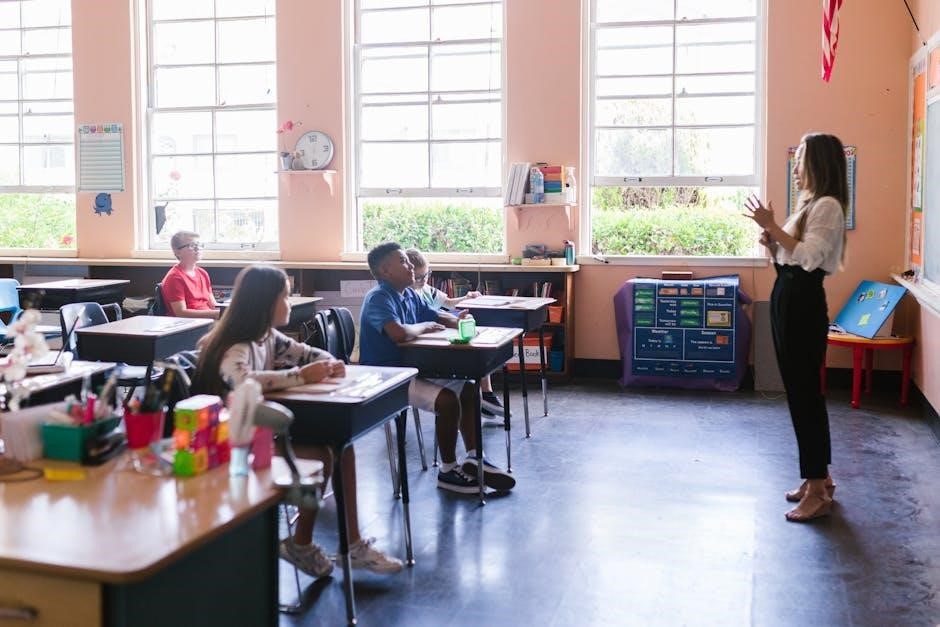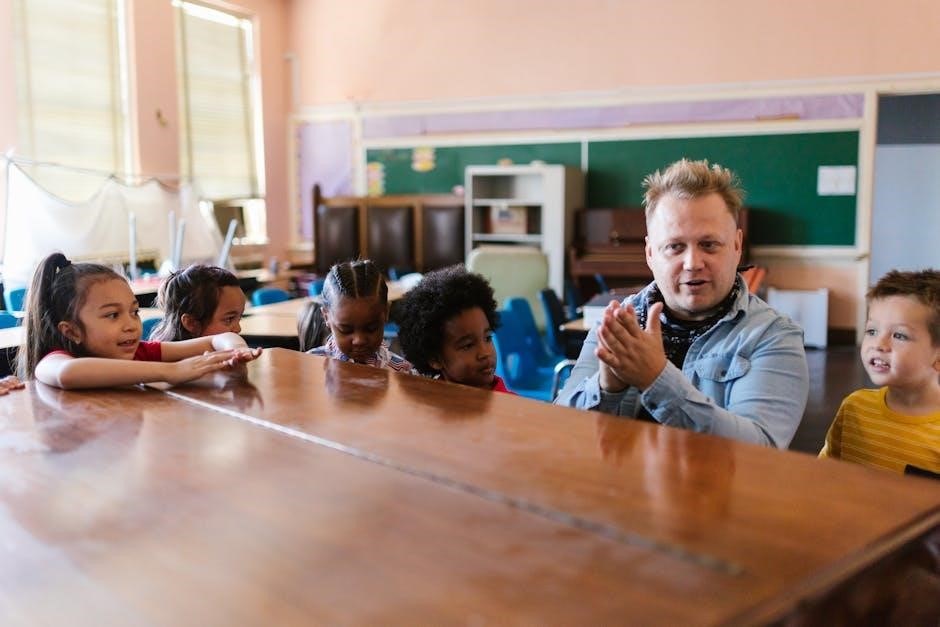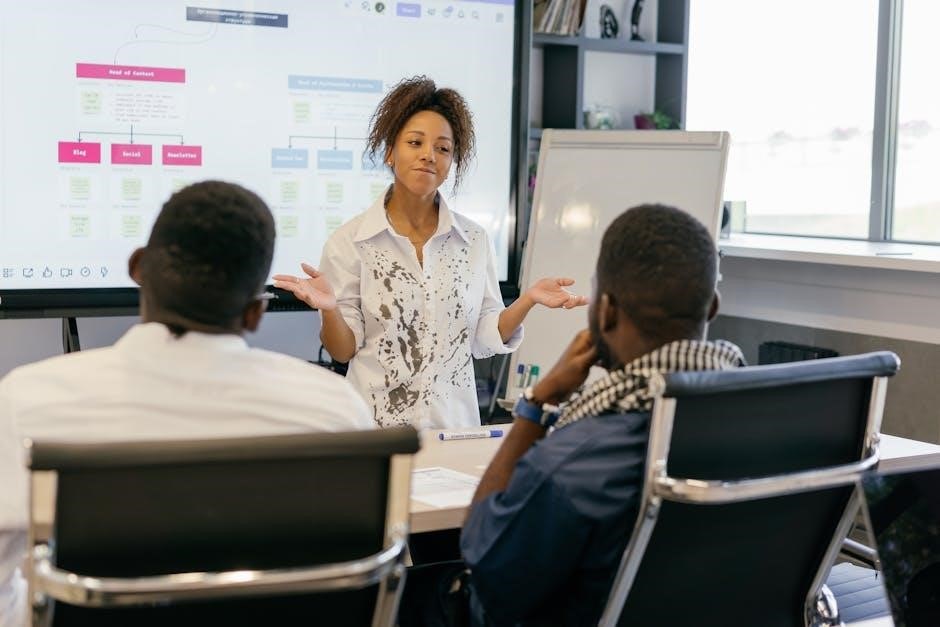Small group instruction focuses on personalized learning, fostering engagement and collaboration. A recent study highlights its effectiveness in improving student outcomes and perceptions of teaching excellence.
1.1 Definition and Overview
Small group instruction is a teaching method involving groups of 3–8 students, fostering active participation and individualized attention. It emphasizes interactive learning, allowing teachers to address diverse needs. A recent study highlights its effectiveness, as students rate small group interactions highly, improving perceptions of teaching excellence and learning outcomes. This approach bridges gaps in traditional instruction, promoting engagement and personalized growth.
1.2 Importance in Modern Education
Small group instruction is vital in modern education, fostering personalized learning and higher student engagement. A 2024 study shows that smaller groups enhance student outcomes, as they allow for tailored instruction and increased interaction. This method addresses diverse learning needs, preparing students for collaborative environments. Its effectiveness is evident in improved academic performance and positive feedback from both students and educators regarding teaching quality and student satisfaction.
Key Characteristics of Small Group Instruction
Small group instruction emphasizes personalized learning, collaboration, and active participation. It involves tailored teaching methods, fostering engagement and addressing diverse student needs, as supported by recent studies.
2.1 Group Size and Dynamics
Small group instruction typically involves 3-8 students, allowing for meaningful interaction and personalized attention. The dynamics focus on fostering collaboration, active participation, and tailored feedback, enhancing the learning experience.
2.2 Interactive Learning Environment
An interactive learning environment in small groups encourages dialogue, problem-solving, and critical thinking. Digital tools and collaborative activities enhance engagement, creating a dynamic setting where students can express ideas and learn from peers.

Benefits of Small Group Instruction
Small group instruction offers personalized attention, increased student engagement, and tailored learning experiences. It fosters collaboration and improves academic performance, making it an effective educational strategy.
3.1 Enhanced Student Engagement
Small group instruction promotes enhanced student engagement by creating an interactive environment where students actively participate in discussions and activities. This setting allows for personalized attention, fostering a deeper connection to the material. Students feel more comfortable contributing ideas, leading to increased motivation and involvement. The collaborative nature of small groups also encourages peer-to-peer interactions, further enhancing engagement and overall learning experiences. This approach ensures students are more focused and invested in their education.
3.2 Personalized Learning Opportunities
Small group instruction offers personalized learning opportunities, allowing instructors to tailor teaching methods to individual student needs. This approach enables targeted support, addressing specific knowledge gaps and learning styles. Students receive more direct feedback, fostering improved understanding and academic performance. Personalized learning in small groups ensures that each student’s unique requirements are met, creating a more inclusive and effective educational environment.

Planning Effective Small Group Sessions
Effective small group sessions require clear objectives, organized materials, and structured activities. Planning ensures focused engagement, maximizing learning outcomes and fostering a productive, interactive environment for all students.
4.1 Setting Clear Objectives
Setting clear objectives is essential for effective small group instruction. It ensures activities align with learning goals, enhancing focus and engagement. Objectives should be specific, measurable, and tailored to student needs, allowing for targeted support and assessment of progress. Clear goals also help educators design relevant materials and activities, ensuring sessions are purposeful and productive for all participants.
4.2 Selecting Appropriate Materials
Selecting appropriate materials is crucial for small group instruction. Materials should align with learning objectives, engage students, and cater to diverse learning styles. They must be relevant, accessible, and adaptable to meet individual needs. Incorporating digital tools and hands-on resources can enhance interactivity. The right materials ensure sessions are productive, fostering deeper understanding and active participation among students, while also supporting the instructor’s teaching strategies. This step is vital for achieving desired educational outcomes effectively.

Strategies for Successful Small Group Instruction
Successful small group instruction relies on active participation and collaboration. Techniques like group discussions, problem-solving tasks, and peer teaching enhance engagement and learning outcomes effectively.
5.1 Active Participation Techniques
Active participation techniques in small group instruction include think-pair-share, role-playing, and problem-solving activities. These methods encourage students to engage deeply, fostering critical thinking and collaboration. Regular formative assessments ensure alignment with learning goals, while immediate feedback enhances understanding. Such techniques not only boost engagement but also cater to diverse learning styles, creating an inclusive and dynamic learning environment for all participants.
5.2 Encouraging Peer Collaboration
Encouraging peer collaboration in small group instruction involves fostering teamwork and shared responsibility. Strategies like group projects, role-playing, and structured discussions promote mutual support and collective problem-solving. By assigning complementary roles, educators ensure diverse perspectives are valued. This approach enhances communication skills, builds trust, and deepens understanding, creating a cooperative learning environment that prepares students for real-world scenarios.

Assessing and Providing Feedback
Assessment and feedback are crucial for evaluating student progress and understanding. Regular formative checks and constructive comments guide improvements, ensuring personalized learning and skill mastery in small groups.
6.1 Formative Assessment Methods
Formative assessments in small group instruction involve ongoing monitoring of student progress. Methods include observations, informal quizzes, and class discussions to gauge understanding. These strategies allow educators to identify areas where students may need additional support, ensuring personalized attention. Regular check-ins help refine teaching approaches, fostering a dynamic learning environment that adapts to student needs and promotes deeper engagement with the material. This approach enhances overall learning outcomes effectively.
6.2 Constructive Feedback Practices
Constructive feedback in small group instruction involves providing specific, actionable comments to guide student improvement. Techniques include offering praise, identifying areas for growth, and encouraging self-reflection. Immediate and relevant feedback helps students track progress, fostering engagement and accountability. This approach enhances learning outcomes and strengthens teacher-student relationships, ultimately benefiting student success in a dynamic educational setting.

Managing the Classroom Environment
Effective classroom management involves organizing spaces, minimizing distractions, and ensuring accessibility. A well-structured environment supports small group dynamics and fosters productive interactions among students and instructors.
7.1 Grouping Strategies
Effective grouping strategies involve mixing students with diverse abilities to foster collaboration. Heterogeneous groups encourage peer learning, while homogeneous groups allow targeted support; Flexible grouping adapts to lesson needs, ensuring engagement and minimizing distractions. Strategic grouping enhances differentiated instruction, catering to individual learning styles and promoting active participation in small group settings.
7.2 Minimizing Distractions
To maintain focus, create a structured environment with clear expectations. Use visual reminders and noise-level monitoring tools. Ensure groups are spaced appropriately and face each other to reduce peripheral distractions. Encourage active listening and respectful communication. Establishing a signal for transitions or refocusing can also help minimize interruptions and keep students engaged in their tasks.

Integrating Technology
Integrating technology enhances small group instruction through interactive tools and online platforms, fostering collaboration and personalized learning experiences tailored to student needs effectively.
8.1 Digital Tools for Engagement
Digital tools like interactive whiteboards, educational apps, and collaborative software boost engagement in small group instruction. These tools facilitate real-time interaction, making learning dynamic and inclusive for all participants. They also enable teachers to track progress and provide immediate feedback, enhancing the overall learning experience and student outcomes effectively.
8.2 Online Platforms for Collaboration
Online platforms such as Google Classroom and Microsoft Teams facilitate seamless collaboration in small group instruction. These tools allow students to share resources, work on projects together, and communicate effectively. Educators can also use these platforms to assign tasks, monitor progress, and provide feedback, ensuring that learning is both interactive and productive in a digital environment.

Measuring the Effectiveness
Measuring effectiveness involves comparing student outcomes in small group instruction with traditional methods, ensuring data-driven insights for continuous improvement.
9.1 Evaluating Student Outcomes
Evaluating student outcomes in small group instruction involves assessing academic performance, engagement levels, and skill development. A recent study highlights significant improvements in student learning achievement and perceptions of teaching excellence, particularly when small group interactions are prioritized. These metrics provide educators with actionable insights to refine their instructional strategies and enhance overall educational effectiveness.
9.2 Comparing with Traditional Methods
Research indicates that small group instruction often surpasses traditional methods in fostering student engagement and personalized learning. Studies show improved academic outcomes and higher student satisfaction compared to larger classroom settings. Small group dynamics allow for tailored instruction, enhancing the quality of education and student-teacher interactions, making it a preferred approach in modern educational frameworks.

Challenges and Future Trends
Small group instruction faces challenges like managing diverse learner needs and resource allocation. Future trends include integrating advanced digital tools to enhance personalized learning experiences.
10.1 Overcoming Common Challenges
Small group instruction often faces challenges like managing diverse learner needs and ensuring equitable participation. To overcome these, educators can use flexible grouping strategies, differentiated materials, and technology to support personalized learning. Active participation techniques and clear communication help maintain engagement and address potential disruptions. Leveraging digital tools also enhances collaboration and streamlines instruction, making small group teaching more effective and manageable in diverse classroom settings.
10.2 Emerging Trends in Small Group Instruction
Emerging trends in small group instruction include the integration of AI-driven adaptive learning tools and real-time assessment technologies. Personalized learning platforms are gaining traction, enabling tailored instruction for diverse learners. Hybrid learning models, blending in-person and online collaboration, are also rising in popularity. These innovations enhance engagement, streamline feedback, and foster more dynamic, inclusive learning experiences, preparing students for future challenges in education.

